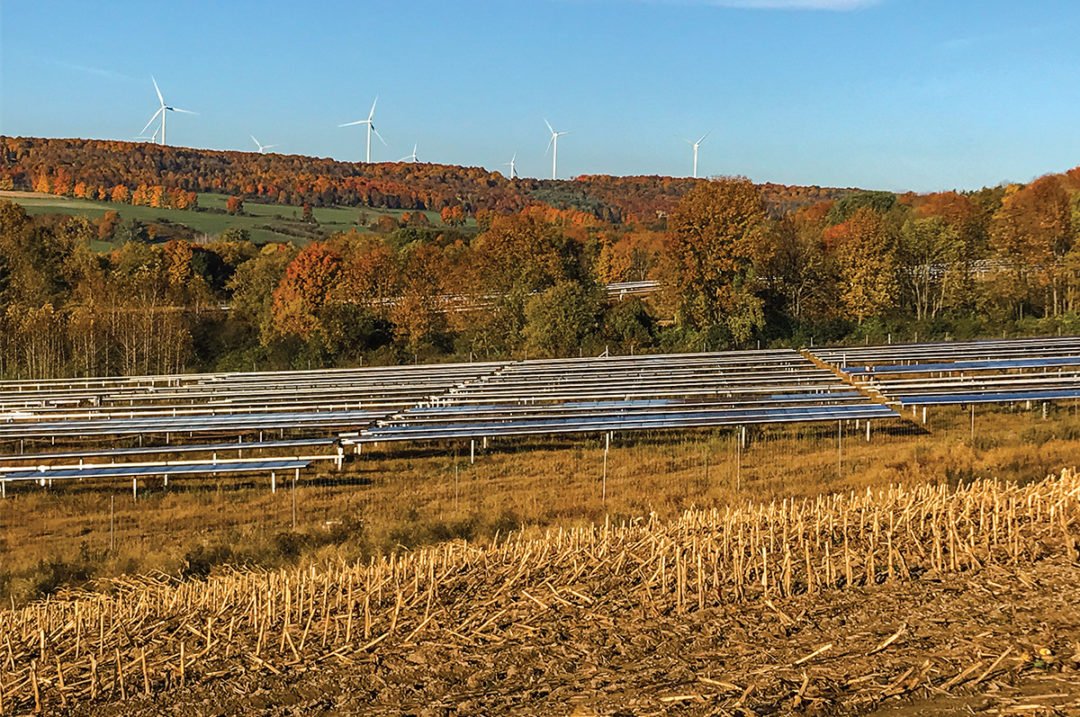Solar energy production is being rapidly deployed across the U.S. in a transition to cleaner energy sources. Advancements in solar technology have significantly increased its efficiency in recent decades and more advances are on the horizon. Despite this trend, solar still requires a great deal of land per megawatt (MW) of energy produced, which has presented significant competition to crop production in many agricultural areas.
The energy production goals being set and the date to achieve them continue to be adjusted. Using any of these projections, and current industry benchmarks of four to six acres needed per MW of energy produced, the total land needed measures in millions of acres. While arid regions and developed areas, such as rooftops and parking lots, are often discussed, in areas of the country where dairy and field crops dominate current land use, these acres are “low hanging fruit” for solar development.
The large open spaces represented by agricultural fields are logistically and economically efficient locations, and current policies designed to accelerate the build-out of solar prioritize the use of the most convenient locations, rather than the most strategic locations.
Food and energy production are two of the most important issues of our times. Productive agricultural soils are a finite resource, and their protection should continue to be a priority. As with everything, a balance is needed to address both challenges. With recognition of the competing needs, and the trajectory of solar development already being experienced in many agricultural areas, it is important to consider some of the current talking points and opportunities to more strategically advance both areas.
AGRIVOLTAICS
The idea of dual use, (producing an agricultural product within a solar array) also known as agrivoltaics, is a popular talking point and while efforts to improve these practices should continue, it is also important to talk realistically about the applicability of this concept within different agricultural systems.
Current efforts in areas such as grazing animals and some specialty crops show promise for their ability to allow both energy and food production to perform at a high level. However, in many cropping systems there are fundamental challenges.
Field and forage crops represent significant acreages in North America and are grown on some of the most desirable parcels for solar development. To date it has proven much more difficult to find synergies between these crops and solar development, with notable productivity tradeoffs for both. More work is needed to evaluate these tradeoffs and understand if these approaches can be considered meaningful strategies towards our goals of minimizing the impact on land use conversion while meeting energy needs.
LAND USE PLANNING AND DEVELOPMENT REQUIREMENTS
While many state and federal policies are driving the build-out of solar, in many areas local entities continue to have a meaningful ability to influence the total number of acres impacted by a solar array. For this, the number of acres needed by a solar array can be separated into two categories. First is the actual project footprint. Second is additional land impacted by the project. Local land use requirements can have unintended consequences regarding how they impact agricultural operations. These challenges have largely been related to required setbacks, fencing and other screening, and land-use ratios.
The placement and spacing of solar panel within an installation is influenced by many factors, with the goal of optimizing the productivity of each panel, and the total energy produced within the footprint. Land-use ratio requirements for a parcel of land can adversely affect this, resulting in less energy production per acre, and additional acres being taken out of agriculture.
Setbacks from roads are often intended to minimize the visibility of a solar array. While the setback area may still be utilized for crop production, the size, shape, and accessibility of these areas can limit cropping opportunities, resulting in lower productivity and increased cost, or these areas being abandoned for agricultural purposes altogether.
Topographic features, parcel shape, and proximity to wooded areas all affect the shape of a solar array and often lead to unconventional shapes. As with the consideration for setbacks, the placement of fencing relative to the shape of the solar array can impact the ability to farm the land outside of the solar array. Additionally, when dual use opportunities do exist, the placement of the fence can also impact these opportunities within the solar array.
Allowing adjustments to setback requirements and fence placement can minimize the loss of agricultural land.
MARGINAL LAND
Differences in a soil's suitability for crop production are highly variable as are the definitions for a marginal soil. Soil categories defined by the United States Department of Agriculture (USDA) and other entities address the inherent qualities of a soil to support crop production and act as a good starting point. Additionally, a farm business will consider many other factors about a given field or parcel when evaluating its value to the farming operation. These factors can include location, uniformity, shape, size, and accessibility, among others.
Producing crops on marginal land brings its own set of environmental and economic challenges, and in many cases, there can be merit in prioritizing these areas for other development versus our most productive soils. However, these same factors can impact how attractive a parcel may be for solar development. A key difference being that while these parcel characteristics can be more challenging for building the solar array, they are less likely to impact the efficiency of energy production in contrast to their effect on crop production. Efforts should be made to further incentivize solar development on marginal land while recognizing the potential development challenges.
 |
This article appeared in PRO-DAIRY's The Manager in March 2024. To learn more about Cornell CALS PRO-DAIRY, visit PRO-DAIRY. |










